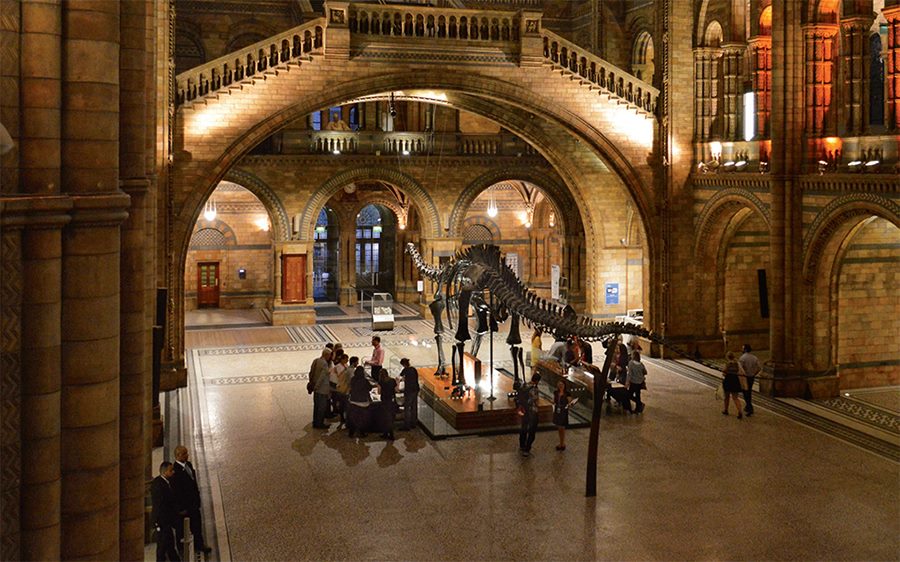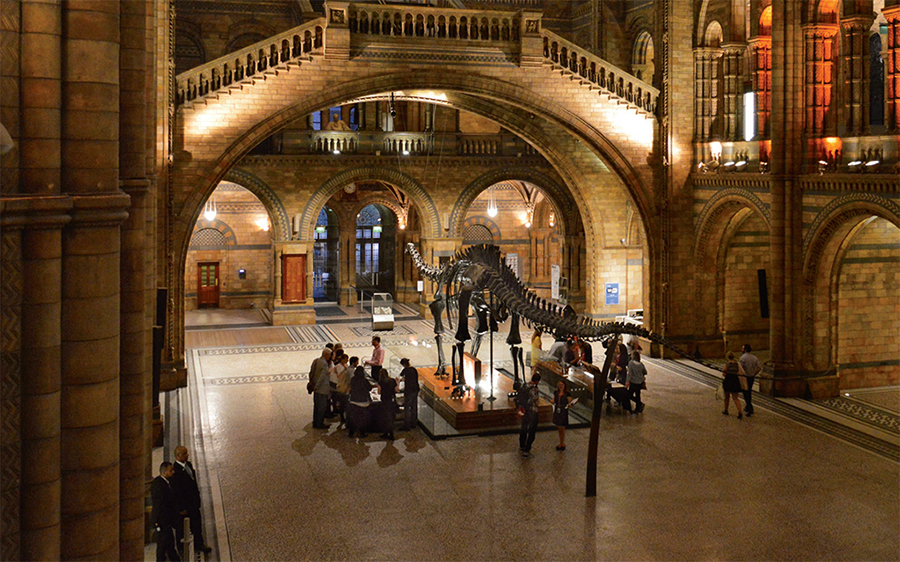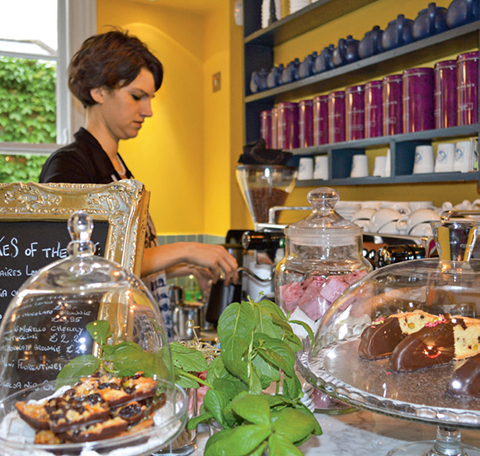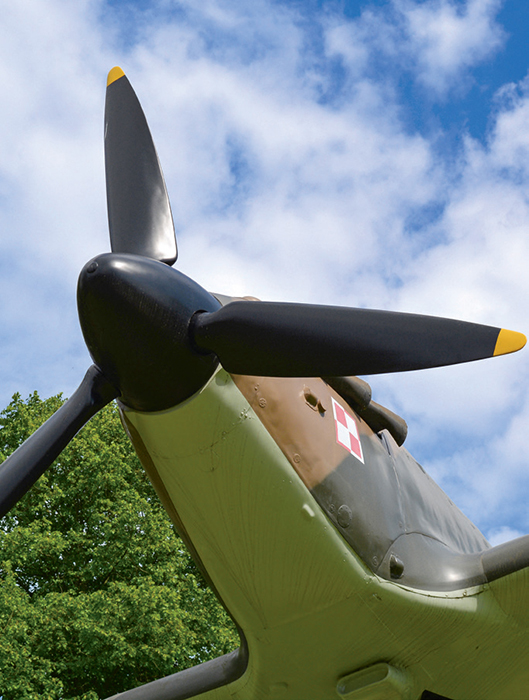
T-Rex Fright, the Battle of Britain and a Chocolate Fix
It’s exhibition season in London and 2015’s harvest is prAoving to be an exceptional vintage. Every museum in town seems to have a major new show, and those that don’t are creating fantastic events to draw in the crowds.
Perhaps the hottest exhibition this summer is the V&A’s Shoes: Pleasure and Pain. It’s safe to say both pleasure and pain are amply covered, but this is no bog-standard history of footwear. Instead, more than 250 pairs of historic and contemporary shoes, some of which are more than 2,000 years old, are grouped into themes exploring the lengths people will go to for fashion. There are teeny-tiny “lotus” shoes made for Chinese women in the 18th and 19th centuries, ludicrously high Vivienne Westwood platforms that Naomi Camp-bell fell off in 1993, and extremely high lace-up boots dating back to Victorian times that wouldn’t look out of place in a Soho backstreet. The exhibition asks why humans, both male and female, have coveted, collected, obsessed over and even fetishized footwear for millennia.
One very unexpected, yet welcome section looks at shoes in folklore and fiction, from Puss in Boots to the Ruby Slippers, the original claret ballet pumps worn in The Red Shoes to the glass slippers worn in Disney’s latest version of Cinderella. Marilyn Monroe, Queen Victoria, Sarah Jessica Parker, Princess Diana and the most notorious shoe-connoisseur of all time, Imelda Marcos, are all here. Provocative, scary, gravity-defying, dainty or just plain impractical, their shoes say far more about them than any other piece of clothing possibly could. This is a monster of an exhibition, a true must-see and hugely popular. It runs until January 31, 2016, but do allow plenty of time to see all the exhibits.
[caption id="TRexFrighttheBattleofBritainandaChocolateFix_img3" align="aligncenter" width="900"]

VICTORIA AND ALBERT MUSEUM
I’VE ALWAYS THOUGHT OF THE V&A as the grown-ups' domain and next door’s Natural History Museum as the kiddies’ playground. After-hours Night Safaris, however, combine mini lectures by scientists from the museum with object handling and the rare chance to experience the UK’s second most popular museum (after the British Museum) almost completely empty, at your leisure.
The famous Hintze Hall, a sort of Victorian cross between a gothic cathedral and a baronial castle, glows in oranges and pinks. Stone birds settle on exotic stone fruit. Stone monkeys scamper up stone columns covered in stone ivy.
If you’ve seen the movie Night at the Museum you’ll know why, as I wandered around the dinosaur section alone in the dark, I wished I hadn’t. During the day the animatronic T-Rex scares the living daylights out of visitors, but on my own as a great yellow eye rolled, then a massive head turned and roared, I took a physical step backwards. Less scary was the animatronic baby raptor who shamelessly upstaged the scientist trying to talk about mammoths in London’s Ice Age.
Every event is topical, ranging from animal mating habits for Valentine’s Day to motherhood in mammals for Mothering Sunday. It was great to have serious, one-to-one discussions with experts about grown up stuff, but wandering through the great halls of one of the world’s most important collections, practically alone, was a true privilege. Night Safaris alternate a monthly slot with adult sleepovers, which have more of an entertainment slant, including music and performances. You do need to book in advance, but not much—there’s generally plenty of capacity and it’s a big museum.
I WAS STAGGERED TO HEAR of the existence of the Battle of Britain Bunker, deep in what was once RAF Uxbridge, West London. It’s exactly what it sounds like: a gigantic hole, 45 feet underground, encased in 5 feet of concrete, from which the entire Battle of Britain was directed.
After descending countless steps and passing numerous iron doors, we entered a large room. Taking up most of it, a massive map of England’s south coast and the north coast of France was littered with wooden markers representing planes, both enemy and allied. Banks of colored lights covered the wall behind. Enemy sighted. Ordered to readiness. In position.
Someone here had to calculate how much fuel each pilot had, how far it would get him and the odds of meeting an enemy plane on the way. It was tough, split-second and complicated decision-making, largely done by women. Above the map room looms a giant curved window to the observation room. Winston Churchill and Dwight Eisenhower both spent sleepless nights watching operations from here, unable to join in, command or even comment. It’s said Churchill, banned from smoking, chewed his way through entire cigars. I can’t recommend this place enough. It’s run by volunteers and open, officially, once a month. If you are planning a visit to the UK and fancy seeing the bunker, drop them a line before you leave.
IF YOU’RE A CHOCOHOLIC and you’ve visited London in the past 30-odd years, you may have come across Rococo. A sumptuous, luxurious shop, it’s famous for its exquisite packaging (white with blue woodcuts) and even more exquisite chocolate. They weren’t voted Chocolatier of the Year 2012 for nothing. When I heard about their latest venture, All Day Chocolate Breakfast, I was at their Belgravia flagship in Motcomb Street in a trice. The shop’s worth visiting for the secret MaRococo back garden alone, all Middle Eastern mirrors and jungle greenery.

SANDRA LAWRENCE
Take the all-day part seriously. Lovely, intense hot chocolate shots, 82 percent salted caramel chocolate spread and Rococo founder Chantal Coady’s signature power granola might be, first thing in the morning, a bit too powerful. Call it afternoon tea, however, and you’ll be in chocolate heaven. Sit in the dappled sunshine under a spreading, ancient plane tree, slather new-baked artisan bread with 71 percent chocolate ganache, bite into a lemon shortbread and feast. The tasting menu is prepared to order, so needs to be booked in advance, but it’s worth it. If you’re going to Rococo, look out for a strange, Greek-style building in the same street with Pantechnicon emblazoned in black over its massive Doric columns. It’s now a pub and upmarket shopping mall, but was in Georgian times a furniture warehouse-cum-art-gallery owned by the Pantechnicon company, whose enormous horse-drawn vans were the predecessors of all house removal trucks today, still known as pantechnicons here in Britain.
To find out what’s happening now in London, do please join me at www.britishheritage.com/around-town-online for more quirky things to do in the capital. Don’t forget to leave a comment, and let me know you’d like to know about. I’m always up for suggestions.

PAUL LINDUS
For More Information
Shoes: Pleasure and Pain
Victoria & Albert Museum, www.vam.ac.uk/content/exhibitions
Battle of Britain bunker
www.raf.mod.uk/battleofbritainbunker
Night Safaris
www.nhm.ac.uk
Rococo
www.rococochocolates.com
The Pantechnicon Building
Motcomb Street





Comments